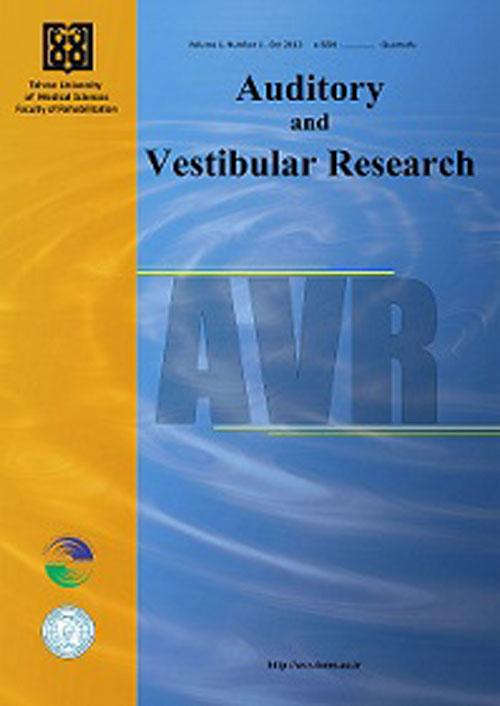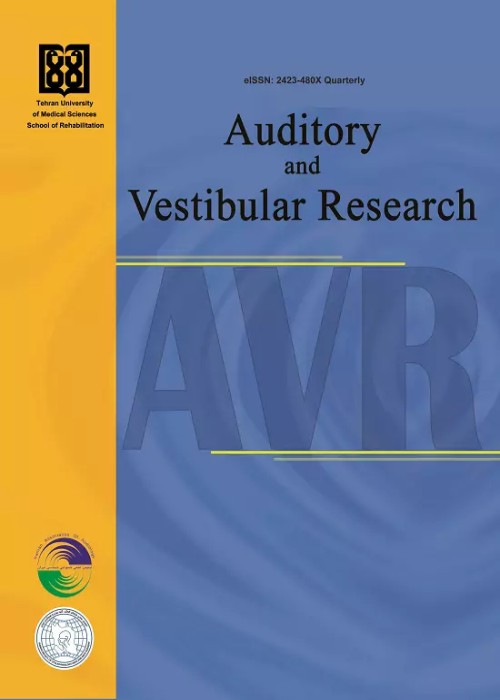فهرست مطالب

Auditory and Vestibular Research
Volume:24 Issue: 3, Summer 2015
- تاریخ انتشار: 1394/05/02
- تعداد عناوین: 8
-
-
Pages 1-10Background And AimFoundations and mechanisms of auditory scene analysis (ASA) including segregation and integration were especially reviewed in the study. I focused on the related studies using event-related potentials (ERPs).Recent FindingsPublications on ASA using ERPs from 1971 to 2014 indicate neural mechanisms of ASA in central auditory system.ConclusionASA results in recognition of different sound stimuli in the competing sound environment. The neural mechanisms of this process could be studied comprehensively using ERPs with good temporal resolution.Keywords: Auditory scene analysis (ASA), Event related potentials (ERPs)
-
Pages 11-18Background And AimMotion sickness (MS) is usually generated when there is a mismatch between the senses which serve balance. One of these senses is related to vestibular system, so it is highly possible that MS reflects in vestibular test results. But there are some conflicts in correlation between vestibular findings and MS. Thus, the objective of this study was to provide an overview of vestibular tests findings in individuals with MS.Recent FindingsIt has been demonstrated that susceptible subjects to different types of MS have more pathologic results in vestibular tests, such as eye movement recordings and vestibular evoked myogenic potentials (VEMPs) results, asymmetry ratios and posturography results in particular.ConclusionBased on abnormalities in various vestibular tests related to MS, possible contribution of signals from any part of the vestibular organ is likely in sensory conflict and triggering MS. Vestibular test results apparently can separate subjects with different susceptibilities to MS, but it seems difficult to differentiate susceptibilities to various types of MS.Keywords: Motion sickness, vestibular test, electronystagmography, vestibular evoked myogenic potentials
-
Pages 19-24Background And AimToday, Bilingualism is a developing phenomenon which half of the world population is bilingual. Auditory system is the main route to language learning, so it is expected that bilingualism has an effect on functions of the auditory system. Auditory memory is one of the auditory processes which is a cornerstone of linguistic skills and learning process growth, so that, it has an important role in language learning. In this paper, functions of the auditory memory in monolinguals and precocious bilinguals have been investigated through dichotic auditory-verbal memory test.MethodsA cross sectional-contrastive study of the Persian version of dichotic auditory-verbal memory test has been carried out among 30 monolingual and 30 bilingual persons. The participants were chosen from both sexes in the age range of 18-30, and test scores have been compared in both groups and sexes.ResultsMean score of dichotic auditory-verbal memory test in monolinguals was 5.47 (from 10), with a standard deviant of 0.55, and in bilinguals were 7.52, with a standard deviant of 0.90, which statistically, it showed a significant difference in scores between the two groups (p˂0.001). There was no significant difference among men and women’s scores in monolingual (p=0.06) and bilingual (p=0.10) groups.ConclusionResults of this limited research showed that there was a considerable functional difference between monolinguals and bilinguals in dichotic auditory-verbal memory test. Therefore, it seems precocious bilingualism has a positive effect on the auditory memory.Keywords: Auditory verbal memory, bilingualism, short term memory
-
Pages 25-31Background And AimDigits are suitable materials for hearing assessment of wide range of patients including children and adults with various language abilities. Single monosyllabic 1-10 digits in triplet formant have been used for measuring speech recognition threshold in signal-to-noise ratio. The purpose of this study was to determine signal-to-noise ratio (SNR) needed for 50 percent correct recognition of Persian monosyllabic digits (1-10) in multi-talker babble noise.MethodsThirty unique triplet set of nine 1-10 monosyllabic Persian digits were created and mixed with multi-talker babble noise. Signal-to-noise ratio varied from -18 to +3 dB in 3-dB steps. Digits were presented binaurally to 17 normal hearing young adults aged 18-25 years. Speech recognition threshold in SNR (SRTsnr) was measured by Spearman-Karber equation and probit regression method.ResultsMean SRTsnr of Persian digits, had minimum value of -12.7 dB for digit 3 and maximum value of -6.8 dB for digit 9. Mean (standard deviation) of SRTsnr was -9.5 (2.1) dB. There was no statistically significant difference between mean SRTsnr of the males and the females for all digits (p>0.05).ConclusionPersian 1-10 monosyllabic digits are not homogeneous in terms of SNR needed for reaching 50% correct recognition. Mean SRTsnr of Persian digits is comparable to German and Polish digits but is higher than English digits.Keywords: Word recognition in noise, digits, normal hearing, Persian
-
Pages 32-42Background And AimOtoacoustic emissions (OAE) and automated auditory brainstem response (AABR) are the most commonly-used methods for universal neonatal hearing screening (UNHS). Various sensitivity and specificity rates have been reported for the OAE and AABR tests as tools for screening newborn hearing. The main objective of this review was to determine the pooled sensitivity and pooled specificity of each of the two devices in comparison with ABR as the gold standard.MethodsA systematic review was performed to evaluate the diagnostic accuracy of the OAE and AABR tests. Research was conducted in the relevant domestic and international databases. There were no time restrictions. The quality of included studies was evaluated with Quality Assessment of Diagnostic Accuracy Study (QUADAS) checklist using the software RevMan 5.1 and results were extracted. After organizing and extracting data, the pooled sensitivity and specificity of OAE and AABR tests were calculated with Meta-Disc software.ResultsA total of 5154 articles were found; 57 articles were investigated in full and 17 articles possessed the inclusion criteria. Analysis was performed on the basis of these results. the quality of the studies was weak (7 cases) to moderate (10 cases). Results of the meta-analysis showed that the pooled sensitivity and specificity of the OAE were 0.77 and 0.93 respectively, and for AABR they were 0.93 and 0.97 respectively.ConclusionThe single stage screening protocol using AABR is an effective alternative to the single stage screening protocol using OAE, which is less accurate.Keywords: Newborn hearing screening, otoacoustic emissions, automated auditory brainstem response, sensitivity, specificity
-
Pages 43-47Background And AimAttention is an important cognitive process that is necessary for educational purposes. Blind people are deprived from the most widely used human sense, the sense of vision. There are reports that blind individuals have a significantly better performance in attentional tasks, as compared with normal subjects. The purpose of this study was to evaluate sustained auditory attention capacity of Persian blind children aged 8 to 10 years.MethodsThis study was performed on 60 blind children (50 boys) aged 8 to 10 years. The control group consisted of 60 normal children (49 boys) at the same age of the test group. In this study sustained auditory attention capacity test (SAACT), otoscopy, Edinburgh and audiometry tests were used. For statistical analysis non-parametric Mann-Whitney U and Chi square tests at p=0.05 significance level were used.ResultsThere was a significant difference in total score of sustained auditory attention capacity test (p=0.038) and Impulsiveness error between blind and normal children (p<0.001). Blind subjects had fewer impulsiveness errors and lower total score. Considering inattentive error (p=1.00) and attention reduction span index (p=0.301), there was no significant difference between the groups.ConclusionIt seems that sustained auditory attention capacity in blind Persian children is larger than age-matched normal group. This can indicate sort of sensory compensation after loss of vision early in life.Keywords: Sustained auditory attention capacity, children, blindness
-
Pages 48-54Background And AimAging is accompanied with changes in cognitive capacities. In spite of advances in neural imaging technologies, there is not a straightforward method to observe cognitive functions. For assessing brain functions, researchers mainly use psychometric tests. The aim of this study was using consonant-vowel (CV) dichotic test as a non-invasive behavioral test for auditory attention (focused and divided attention) and language laterality evaluation in young and old age groups.MethodsIn the present cross-sectional study, Persian version of consonant-vowel dichotic test was performed on 28 young subjects within 18-28 and 27 old subjects within 60-80 year-old age range of both genders. All subjects had normal peripheral hearing and were right-handed. Right and left ear scores were compared under three different attention conditions: divided or non-forced attention, attention to the right ear, attention to the left ear.ResultsIn non-forced condition there was no significant difference for the right ear score between the two age groups (p=0.97) but the left ear score was statistically different (p≤0.001). In addition, there was a significant difference between two ears’ scores in attention to right/left ear for both age groups (p≤0.001).ConclusionIn the older group under divided attention condition, the left ear score was lower than the younger group and they had problem in paying attention especially to the left ear stimuli. In the older group, ear asymmetry for consonant-vowel dichotic test score was higher than the younger one.Keywords: focused attention, divided attention, dichotic consonant vowel test, elderly, bottom up processing, top down processing
-
Pages 55-61Background And AimThe double dichotic digit test (DDT) is a simple test for assessing and screening auditory processing system. The purpose of this study was to develope a double DDT, in Persian language and find its basic norm values in girls aged 7 to 11 years.MethodsThe Persian version of double DDT is composed of 3 different 25 numerical lists. Numbers in each list were recorded dichotically. The present cross‐sectional study was performed on 200 girls aged 7 to 11 years. Test-retest reliability was assessed in 30 of the study subjects.ResultsThe mean scores of the right and left ears in the free recall condition increased from 92.33 and 86 percent in 7 year olds to 99.75 and 98.16 percent in 11 year olds and in the directed condition from 95 and 88.80 percent in 7 year olds to 100 and 98.41 percent in 11 year olds. In the free recall condition the right ear advantage value decreased from 6.33 percent in 7 year olds to 1.58 percent in 11 year olds, respectively and in directed recall condition, decreased from 6.91 percent in 7 year olds to 1.59 percent in 11 year olds. The test has as high consistency reliability (p>0.05).ConclusionAccording to results of the present study, the Persian version of the double DDT has suitable reliability for assessing the central auditory processing system in 7 to 11 year old girls.Keywords: Double dichotic digit test, ear advantage, central auditory processing, children


